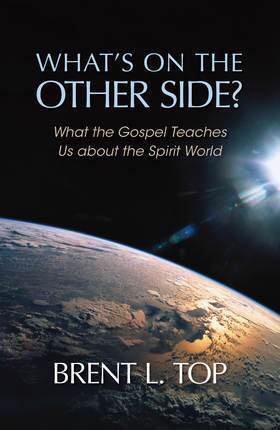The following is an excerpt from Brent L. Top and Wendy C. Top's Beyond Death's Door: Understanding Near-Death Experiences in Light of the Restored Gospel.
Another remarkable and apparently pleasant feature of the spiritual existence is the absence of the measure of time and space as we know it here on earth. “I found myself in a space, in a period of time, I would say, where all space and time was negated” (as quoted in Life at Death, p. 98). The reports of timelessness on the other side bear testimony to the statement of the prophet Alma that “all is as one day with God, and time only is measured unto men” (Alma 40:8). Elder Neal A. Maxwell confirmed that time as we understand it is a temporary fixture.
When the veil which now encloses us is no more, time will also be no more (see Doctrine and Covenants 84:100). Even now, time is clearly not our natural dimension. Thus it is that we are never really at home in time. Alternately, we find ourselves impatiently wishing to hasten the passage of time or to hold back the dawn. We can do neither, of course. Whereas the bird is at home in the air, we are clearly not at home in time—because we belong to eternity! Time, as much as any one thing, whispers to us that we are strangers here. If time were natural to us, why is it that we have so many clocks and wear wristwatches? (Neal A. Maxwell, “Patience,” Ensign, October 1980, p. 31.)
► You'll also like: Life after death: 6 insights into the spirit world
The mention of timelessness is prevalent in near-death reports. Almost without exception, they remark or imply that they have no concept of whether their experience lasted seconds, minutes, hours, years, no time at all, or for an immeasurable duration. They report time as being changed, compounded, or absent altogether.
Even Dr. Carl Jung, the famous psychoanalyst who himself had a near-death experience, recounted, “I can describe the experience as only ecstasy of a contemporal state in which present, past, and future are one” (as quoted by Maurice Rawlings in Beyond Death’s Door, p. 54).
On the concept of timelessness, Emanuel Swedenborg presented a helpful discussion which seems compatible with Latter-day Saint teachings on time and eternity. He reasoned: “A natural person may believe that his thinking would cease if concepts of time, space, and matter were removed, since all man’s thinking is based on them. It would help him to realize, though, that thoughts are limited and restricted to the extent that they draw upon time, space, and matter. They are not limited, and they expand, to the extent that they do not draw upon these, since the mind is proportionally raised above bodily and worldly matters” (Heaven and Hell, p. 132).
Moreover, Swedenborg seemed to propound a principle pertaining to timelessness which Latter-day Saints have always taught. “Since angels have no idea of time,” he wrote, “they have a different concept of eternity than people on earth do. Angels see in eternity an infinite state, not an infinite time” (Heaven and Hell, p. 130–31).
The Lord revealed to Moses that His work and His glory were to “bring to pass the immortality and eternal life of man” (Moses 1:39). We have understood that eternal life does not refer exclusively to the unending duration of life. That is implied in the word immortality. Rather, eternal life refers to a state or quality of life which the Lord wants us to enjoy.
Jesus gave us a hint of the meaning of this eternal type of life just before his crucifixion. “And this is life eternal, that they might know thee the only true God, and Jesus Christ, whom thou has sent” (John 17:3). While we may not grasp the complete meaning of this statement, we believe that knowing—in the fullest sense of the word—our Heavenly Father and his Son encompasses living with Them and becoming like Them.
While we may have some inkling of what timelessness is like, it is even more difficult to conceive “this world where rules about space ... were all suspended” (Return from Tomorrow, p. 45). Some of the comments of NDErs are quite enlightening in this regard, although, as one man explained, “Our normal spatio-temporal vocabulary is frustratingly inadequate to describe heaven” (as quoted in Return from Death, p. 52).
Emanuel Swedenborg explained his understanding of how space and time are overcome or set aside there. Once again, it is similar to other faculties activated by thought. “Whenever an individual in the other life thinks about someone else, he sets the person’s face before himself in his thought, together with many other things that belong to the person’s life. When he does, the other person becomes present as though he were called and summoned. This kind of thing happens in the spiritual world because thoughts are communicated there and because distances do not have the same attributes as they have in the natural world” (Heaven and Hell, p. 400).
While this may sound strange, modern-day visitors to the spirit world seem to be describing a process which sounds very similar. “It came then to my mind to see again those family members and loved ones who had passed on before, and no sooner had I thought the thought then [sic] they were there. ... Next, I wanted to see Jesus, for I had always wished to thank him for the role he played in history and the example he set for others to follow. ... He instantly appeared, without any effort on my part” (As quoted in Coming Back to Life, p. 35).
Another individual described a process of relocation which echoes the prophecies of Brigham Young about travel in the next life. Recall that the prophet taught that “if we want to visit Jerusalem, or this, that, or the other place ... there we are, looking at its streets. ... If we wish to understand how they are living here on these western islands, or in China, we are there” (In Journal of Discourses, 14:231).
This experiencer reported instantaneous arrival at each destination: “About this time, while I was still marveling over what I had seen, my friend suggested we might be on our way; and becoming restless myself, I agreed. IMMEDIATELY we arrived at another location, on a beautiful street.” After visiting this area, the NDEr remarked, “we relocated again, INSTANTLY” (As quoted in “Amazing Grace: The Near-Death Experience as a Compensatory Gift,” Journal of Near-Death Studies, vol. 10, no. 1, Fall 1991, p. 30).
Another experiencer seems to bear witness of both aspects of this absence of intervening space in the spirit realm. Others have also mentioned the “telephoto lens effect” described here. “Whenever I would look at a person to wonder what they were thinking,” marveled one woman who had left her body following an accident, “it was like a zoom-up, exactly like through a zoom lens, and I was there. But it seemed that part of me—I’ll call it my mind—was still where I had been, several yards away from my body. When I wanted to see someone at a distance, it seemed like part of me, kind of like a tracer, would go to that person. And it seemed to me at the time that if something happened any place in the world that I could just be there” (As quoted in Life After Life, pp. 51–52).
This may offer us a glimpse of the fulfillment of a promise which is basic to [Latter-day Saint] theology—that if we are faithful to all we have been taught, we will be with our loved ones forever, never to be separated again. In our earthly thinking, it is almost impossible to comprehend how we might all be together without at least some intervening distances between us. Apparently, we will have the power to overcome all obstacles—to visit and communicate with friends and loved ones, instantly, if we desire. Distance and separation will never again have the deterrent effect on relationships which they have here on earth.
As with accounts of the other unimaginable delights of the next life, the descriptions of this phenomenon could stretch on for pages, each as exhilarating as the one before. Those of us who have never experienced these views are at least blessed to have these wonderful reports to supplement our doctrinal understanding and can endeavor to imagine for ourselves the unimaginable joys that lie ahead.


